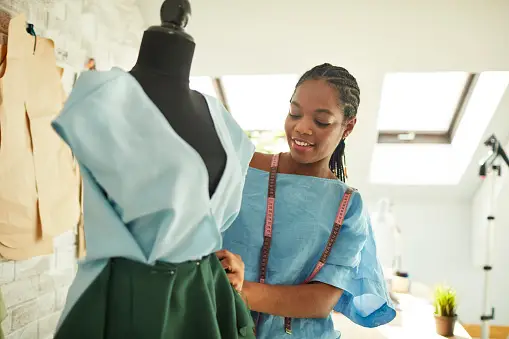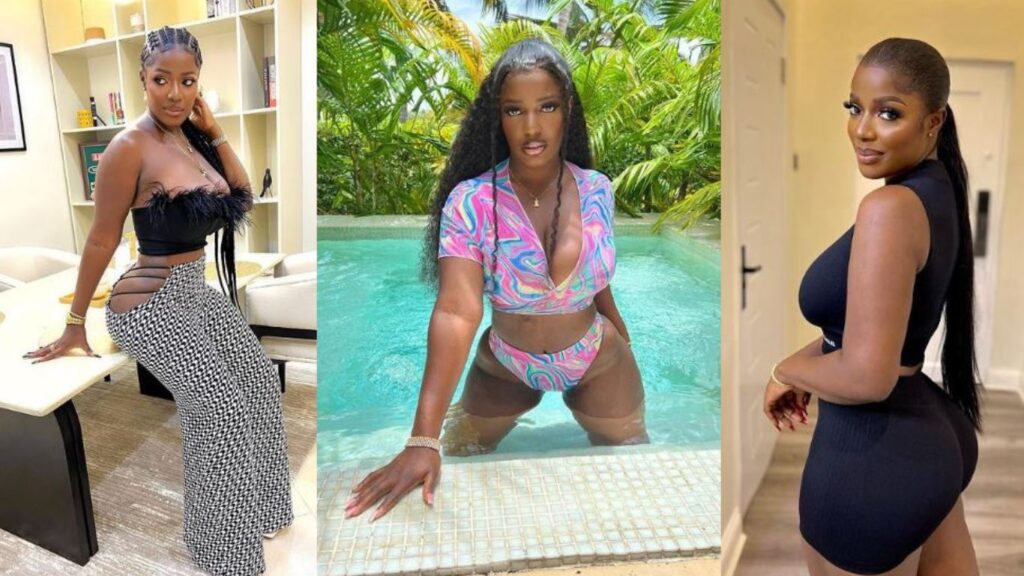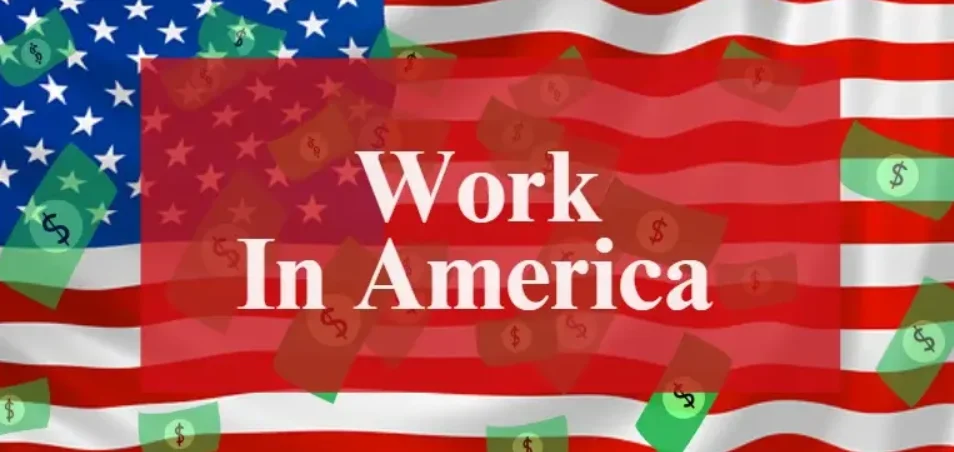
If you are a skilled dressmaker or an accomplished dress designer from abroad, and you’re seeking to flourish within the dynamic and illustrious U.S. fashion scene, this extensive manual will serve as your roadmap. Even as an international candidate, the prospect of achieving your career dreams in the USA is within reach provided you strategically navigate through the job search and visa sponsorship procedures. Herein, we’ll delve into the various strategies for international dressmakers and designers aiming to gain employment in the USA, complete with an in-depth walkthrough of the visa sponsorship process to ensure your legal working status.
In-depth Understanding of Visa Sponsorship for International Dressmakers and Designers
Visa sponsorship signifies the commitment by a U.S. employer to back an international professional’s application for a work visa, thus authorizing the individual’s legal employment within the country. For the domain of dressmaking and design, various types of visas can be applied for; notably, the H-1B visa suits those in specialty roles, whereas the O-1 visa is intended for individuals with an extraordinary caliber or accomplishments in their respective domain.
Comprehensive Exploration of Visa Types Suitable for Dressmakers and Dress Designers
The H-1B visa stands out as the predominant choice for many in the field of dressmaking and design. Tailored for those with specialized proficiency and a distinctive skill set in a certain capacity—such as a profound understanding of fashion design principles or expertise in garment creation—it presents a viable avenue for those with qualified fashion-centric backgrounds. To be eligible for the H-1B visa, aspirants are required to secure an offer of employment from a U.S. company and must fulfill the stringent educational and professional prerequisites outlined by the immigration authorities.
Conversely, the O-1 visa caters to a select group with proven superlative skill or notable achievements in their craft. This includes internationally acclaimed fashion designers or distinguished couturiers with a track record of success and recognition in the industry. Though the eligibility requirements for the O-1 visa are quite demanding, including the necessity to substantiate a history of professional distinction and industry-wide acknowledgment, the benefits it confers—such as heightened flexibility and repute—make it a prized and esteemed option for those who meet its standards.
Detailed Eligibility Criteria for Visa Sponsorship Acquisition
To become an eligible candidate for visa sponsorship, prospective dressmakers and designers must satisfy a series of criteria defined by the U.S. Citizenship and Immigration Services (USCIS). These include but are not limited to obtaining relevant educational credentials or work experience, gaining a job offer from a sponsoring U.S. employer, and proving English language proficiency. Beyond these requirements, applicants should be able to affirm that their work engagement in the U.S. will not adversely affect the domestic job market for American citizens.
Survey of Employment Prospects for Internationally Trained Dressmakers and Designers in the USA
Across the vast expanse of the United States, a treasure trove of employment possibilities unfolds for adept dressmakers and designers. From boutique fashion enterprises to sprawling design firms, and bustling garment manufacturing plants, there is an assortment of avenues where international talent is actively sought. Particularly, metropolises such as New York, Los Angeles, and San Francisco stand out as epicenters of the fashion trade, providing plentiful job openings for those hailing from other nations.
Assorted Employer Types Actively Seeking Dressmakers and Dress Designers
- Esteemed Fashion Houses: These bastions of sartorial excellence, which encompass high-profile brands and couture labels, often seek the dexterity of dressmakers and designers to produce tailor-made, exquisite apparel. Renowned for a staunch focus on superior artisanship and meticulous attention to the minutest of details, these institutions stand as quintessential workplaces for talent with refined dressmaking skills.
- Innovative Design Studios: These are sanctuaries for creative minds, where adept professionals are charged with devising cutting-edge fashion concepts to cater to eclectic clienteles. Being a part of a design studio affords dressmakers and designers the unique chance to amalgamate their skills with those of other artists, contributing collaboratively to avant-garde fashion undertakings.
- Industrial Garment Manufacturers: In the mass production landscape, manufacturers are on the lookout for dressmakers who can deliver consistency, precision, and a high standard of quality in apparel creation. Although the nature of the work may skew towards the monotonous, these positions offer reliable job security and present the prospect for upward mobility within the company.
Prominent Urban Hotspots for Fashion Industry Careers
- New York City: Reigning as the heartland of American fashion, this metropolis abounds with myriad roles spanning design, manufacturing, and retail. New York City is a melting pot, housing famed designer brands, influential fashion magazines, and distinguished fashion academies. Its pulsating energy acts as a magnet, drawing in dressmakers and designers from every corner of the globe with promises of endless opportunity.
- Los Angeles: Celebrated for its diverse and effervescent fashion scene, especially known for casual and celebrity-inspired styles. LA is peppered with a rich variety of fashion entities—from renowned designer firms to edgy streetwear labels—making it an enticing environment for dressmakers and designers eager to leave an indelible mark in the fashion realm.
- San Francisco: A burgeoning center for sustainable and technology-infused fashion innovations. San Francisco presents a compelling mix of creative ingenuity, business acumen, and a conscientious approach to sustainability, rendering it a prime location for dressmakers and designers who are passionate about pioneering ethical fashion trends and practices.
Credentials and Competences Vital for Achieving Success
To excel and rise within the formidable U.S. fashion industry, it is crucial for dressmakers and designers to be equipped with the pertinent qualifications and capabilities.
1. Essential Educational Background
While a formal education in fields akin to fashion design or related disciplines can be advantageous, it’s the firsthand experience and substantive portfolios that often carry significant weight with potential employers. Multiple dressmakers and designers have cultivated their skills via direct practice, apprenticeships, or rigorous self-study, establishing their artistic capacities and innovative flair through the quality of their workmanship and designs.
2. Fundamental Technical Skills
Mastery of pattern drafting, sewing, draping, and advanced garment construction stand as core competencies that dressmakers and designers must possess to thrive professionally. Typically gained through a blend of academic preparation and practical seasoning, these capabilities enable dressmakers to transform theoretical design visions into tangible, well-crafted pieces with exactitude and finesse.
3. Key Interpersonal Skills Treasured in the Fashion Sector
Alongside technical proficiency, ingenuity, precision, effective time management, and the capacity to work synergistically are essential soft skills that amplify a dressmaker’s or designer’s performance in collaborative settings and contribute significantly to their overall success. The industry greatly values individuals who can communicate clearly, adapt to evolving creative demands, and sustain high levels of craftsmanship under pressure.
Creativity and the ability to approach challenges with innovative solutions are enormously prized qualities in the ever-evolving landscape of the fashion industry.
In-Depth Salary Insights
The United States offers a diverse range of remuneration prospects for dressmakers and fashion designers. Earnings can fluctuate extensively, influenced by one’s professional experience, geographical location, and the reputation of the employing brand. Those starting their careers might anticipate a yearly compensation between $30,000 to $50,000, while seasoned experts boasting specialized expertise or positions within elite fashion labels could command salaries exceeding $100,000 per annum. For those who venture into freelancing, income is project-dependent, with fees contingent upon the intricacy and magnitude of the projects undertaken.
Cultivating Industry Relationships
Deliberate engagement at fashion industry gatherings, runway shows, and mixers designed for networking provides dressmakers and designers with the chance to forge connections with potential hiring entities, peers, and key figures influencing the industry. Establishing a network with these individuals can pave the way to a plethora of opportunities such as job propositions, cooperative projects, and valuable guidance from established mentors.
Engaging with Professional Platforms
Utilizing professional and industry-specific online platforms including LinkedIn, FashionUnited, and StyleCareers allows dressmakers and designers to put their creative work on display, connect with headhunters, and stay abreast of shifting industry tendencies. Active participation and interaction with pertinent materials on these services can markedly boost one’s networking outreach and overall presence in the fashion scene.
Amplifying Social Media Presence
Through social media platforms like Instagram, Pinterest, and Behance, dressmakers and designers can effectively exhibit their portfolios, tapping into a worldwide pool of audiences, potential employers, and clientele. Sharing insights into their design inspirations, processes, and finalized pieces can help cultivate a committed audience and establish their influence within the fashion community.
Research-driven Approach to Employers and Personalized Applications
For dressmakers and designers aspiring to secure roles within the United States, comprehensive research into potential employers is absolutely essential.
Identifying Sponsorship Opportunities
Diligently scouting for businesses that have a track record of offering visa sponsorships and customizing applications to their specific needs can significantly amplify the probability of obtaining an employment offer. Numerous companies actively seek global talent, offering visa sponsorships as an integral component of their hiring packages, particularly for specialized or experienced roles.
Discerning Employer Aesthetics and Priorities
Insight into the distinctive design ethos, market placement, and core principles of prospective employers can empower dressmakers and designers to refine their portfolios and application submissions, ensuring harmonization with the company’s brand image. Demonstrating comprehension of the employer’s clientele and their market position, coupled with highlighting a fervor for the field and its products, is highly valued by potential employers.
Application Customization for Target Employers
Carefully curating cover letters and resumes to emphasize salient skills, experiences, and achievements can significantly raise an applicant’s profile within a sea of candidates. Such tailored material should resonate with the applicant’s unique capabilities and suitability for the role while underscoring potential value additions that the candidate might bring to the company.
Mastering the Art of an Impactful Resume and Portfolio
An impeccably curated resume and portfolio are fundamental to the toolkit of every dressmaker and designer keen on making a statement and captivating the attention of potential employers.
1. Emphasizing Pertinent Expertise and Talents
Articulating relevant previous work experiences, internships, and creative endeavors conveys the expertise and aptness of the applicant for the envisioned role. The resume should be fine-tuned to put forth notable achievements, capabilities, and qualifications germane to the job opening, incorporating explicit instances with measurable outcomes wherever feasible.
2. Demonstrating Artistic Originality and Forward Thinking
Presentation of high-resolution images of garment creations, concept art, and design development processes could vividly communicate the creative capacity and proficiency of the candidate. Selections for the portfolio ought to be the pinnacle of one’s work, curated sensibly to align with their personal creative philosophy and aesthetic inclinations.
3. Crafting a Superiorly Designed Portfolio
A professionally orchestrated and visually elegant portfolio not only broadcasts the individual’s craftsman’s skills but also mirrors their meticulousness and sense of professionalism, ingraining an unforgettable impression on possible employers. Craftsmanship in creating a portfolio that convincingly transmits their design ethos, competencies, and adaptability as a visionary should be the ultimate goal for the dressmaker or designer striving for distinction.
Methodical Approach to the Job Application Procedure and Visa Sponsorship
Attaining a lucrative job proposition while negotiating visa sponsorship is a multifaceted undertaking that necessitates detailed planning and deliberate action.
Comprehending the Visa Sponsorship Framework
It is imperative to become well-versed with the intricacies of the visa application scheme – being aware of the indispensable paperwork, compulsory fees, and expected timeframe. Fashion professionals should delve into the visa conditions pertinent to their specialty and seek advice from immigration consultants or legal experts to assure the submission of a thorough and accurate visa application.
Optimizing Interview Readiness
Preemptive practice for likely
To enhance the probability of securing employment, candidates such as dressmakers and designers must diligently prepare for interviews by formulating well-thought-out answers to potential questions about their work experience, skillset, and professional aims. It’s equally critical to exhibit a solid understanding of both the prospective company and the current trends influencing the fashion industry. Employing strategies like participating in mock interviews, seeking constructive critique from peers, and utilizing interview coaching services, can greatly aid in honing communication techniques. These methods not only enable candidates to convincingly present their qualifications and assets but also help bolster self-assurance in their capability to engage effectively during interviews.
Mastering Compensation Negotiation
Securing remuneration that reflects fair market value and conducive work conditions is instrumental for dressmakers and designers. To do so necessitates a thorough comprehension of the prevailing industry pay scales and benefits.
Professionals are encouraged to conduct meticulous research on the typical compensation brackets for their role within their specific geographic setting, considering a variety of elements like the cost of living, current employment demands, as well as their own vault of experience and special skills. When negotiating, it’s essential to factor in non-monetary advantages — health insurance, pension schemes, vacation allowances, and opportunities for career development — aiming for a comprehensive benefits package that not only satisfies personal requirements but also complements professional ambitions.
Navigating Potential Hurdles
Although pursuing a career within the United States as a dressmaker or designer carries the promise of rewarding prospects, it inevitably comes with a set of obstacles that international workers must overcome.
Bridging Cultural Gaps in the Workplace
Acclimating to the distinctive cultural standards and professional modes of operation in the U.S. requires dressmakers and designers to demonstrate adaptability, a broad-minded perspective, and an earnest respect for multiculturalism.
Those embarking on this journey should endeavor to learn about the nuances of American business etiquette, distinct communication methodologies, and prevailing professional norms, seeking support from peers or tapping into cultural orientation initiatives if needed. Cultivating meaningful connections with colleagues across different cultures and participating in company-hosted cultural activities plays a significant role in assisting dressmakers and designers to smoothly assimilate into their new roles while fostering a sense of inclusivity.
Overcoming Language Hurdles
Bettering proficiency in the English language is essential, and can be achieved through enrolling in language courses and engaging in exchange programs which focus on enhancing conversational abilities.
For dressmakers and designers, prioritizing the mastery of English — by practicing speaking, listening comprehension, reading, and writing — is paramount to developing fluency and self-assurance. Immersing oneself in English-language media and utilizing technological aids such as apps and online tools, in addition to formal education, can be great supplements to learning. Furthermore, procuring constructive feedback from language instructors or conversation partners can help in pinpointing areas needing improvement and in monitoring progress over time.
Dealing with Job Rejection
Rejection is a common aspect of the job search experience, but maintaining a constructive mindset, actively soliciting critique, and diligently continuing the hunt for opportunities are essential strategies to move beyond such disappointments and achieve eventual success. Dressmakers and designers ought to regard rejections as educational triggers and chances for development, rather than as indicators of their worth or skill level.
Being proactive in requesting feedback post-rejection can reveal actionable insights, fostering skill enhancement, and refining one’s approach to forthcoming applications. Maintaining tenacity, keeping sight of long-term objectives, and cultivating a network of supportive peers can all greatly assist professionals in enduring the emotional strains of job hunting and staying driven on the path to realizing their career aspirations.
Supporting Resources for Internationally-Based Dressmakers and Designers
A plethora of resources and supportive networks stands ready to aid international dressmakers and designers seeking employment and professional advancement in the USA.
Government Support and Initiatives
Initiatives and information on compliance with visa conditions and employment law can be accessed through agencies such as the U.S. Department of Labor and the United States Citizenship and Immigration Services (USCIS).
Resources available online, as well as consultative services, can guide dressmakers and designers through the intricacies of the visa application process and ensure adherence to the pertinent legislative parameters. Government-endorsed programs such as the Exchange Visitor Program (J-1 visa) and the Optional Practical Training (OPT) program present foreign nationals with avenues to procure valuable on-the-job experience in the U.S., all while retaining lawful immigration status.
Associations and Networking Bodies
Engagement with industry-specific organizations like the Council of Fashion Designers of America (CFDA) or the American Sewing Guild (ASG) can open doors to a wealth of networking chances, educational workshops, and mentorship openings.
By actively participating in such groups, dressmakers and designers can connect with peers, exchange valuable expertise, and remain abreast of ongoing sector trends and innovations. Involvement in continuous professional development initiatives, attending industry seminars, and taking on roles within these organizations can significantly boost a professional’s profile, setting the stage for exciting career opportunities and collaborative ventures within the competitive fashion domain.
Digital Communities and Online Support Networks
Vibrant online communities across platforms like Fashionista, Fashion Network, and Reddit’s r/fashion provide rich soil for dressmakers and designers to seek counsel, exchange narratives, and network with like-minded professionals globally.
Active participation in these digital congregations can enlighten professionals about career openings, sponsorships for visas, and other significant topics. Engaging with industry connoisseurs and burgeoning designers in online settings cultivates an invaluable pool of wisdom, encouragement, and fellowship – all crucial for thriving in an unfamiliar employment landscape and carving a distinctive path in the exhilarating realm of fashion design.
Epilogue
Embarking on a journey as a foreign dressmaker or designer in the USA, with the aid of visa sponsorship, is a tangible and attainable ambition when pursued with appropriate strategy, meticulous preparation, and unyielding determination. By maximizing the potential of networking, customizing application efforts to resonate with prospective employers, and adeptly maneuvering through the visa application process, international talents can actualize their aspirations of making distinctive contributions to America’s vibrant and diverse fashion industry.
A blend of persistence, creative flair, and readiness to tackle challenges can catapult one’s profession to remarkable heights. Whether it be an experienced designer in search of fresh horizons or a recently graduated aspirant poised to make an impression, the United States proffers an abundance of prospects for skilled dressmakers and designers hailing from all corners of the globe. By keeping abreast of industry shifts, forging connections, and perfecting one’s craft, aspirants can set the stage for a fulfilling and prosperous career within the spellbinding and innovative world of fashion.




![Cleaning Jobs In Canada For Foreigners With Visa Sponsorship [APPLY NOW]](https://career.lumpkinpedia.com/wp-content/uploads/2023/08/Screenshot-2023-08-08-7.08.41-AM.png)




